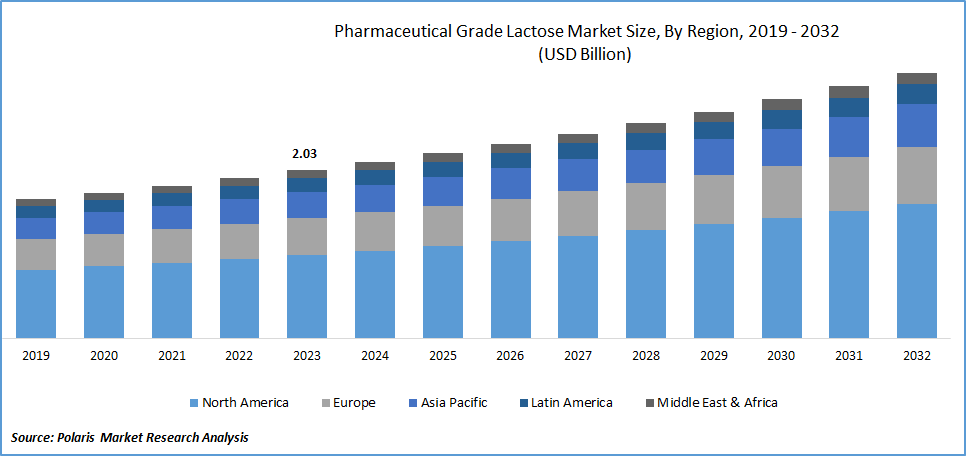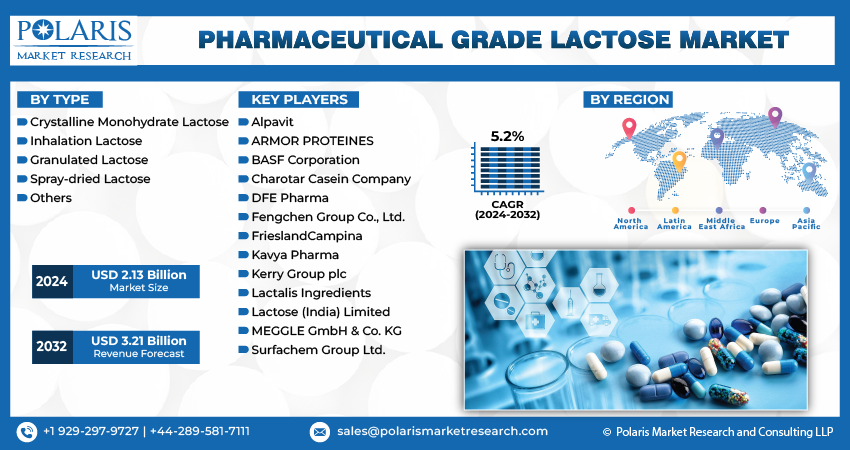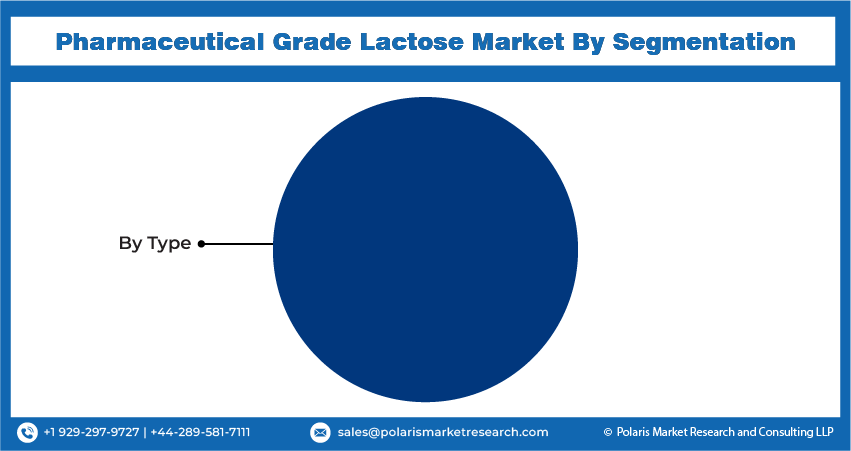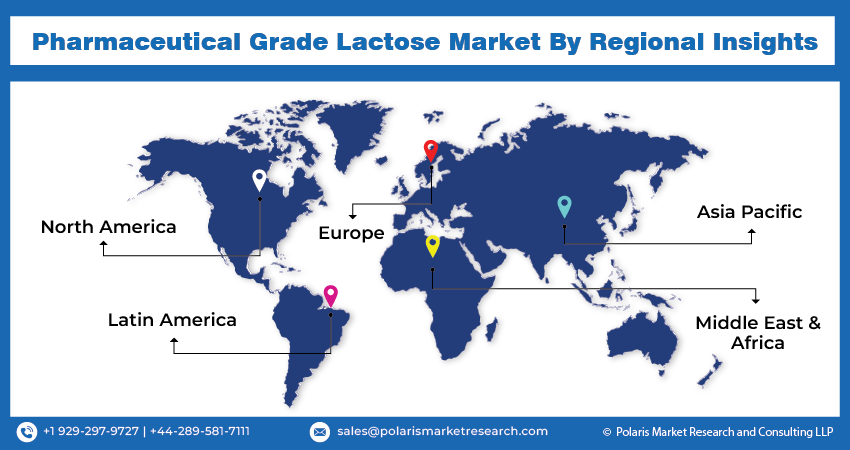
Pharmaceutical Grade Lactose Market Share, Size, Trends, Industry Analysis Report, By Type (Crystalline Monohydrate Lactose, Inhalation Lactose, Granulated Lactose, Spray Dried Lactose), By Region, And Segment Forecasts, 2024 - 2032
- Published Date:Jan-2024
- Pages: 119
- Format: PDF
- Report ID: PM4198
- Base Year: 2023
- Historical Data: 2019-2022
Report Outlook
The global pharmaceutical grade lactose market was valued at USD 2.03 billion in 2023 and is expected to grow at a CAGR of 5.2% during the forecast period.
The rise in pharmaceutical spending by the governments is poised to drive the demand for pharmaceutical-grade lactose. India has gained prominence as a leading global supplier of generic drugs and cost-effective vaccines. The country has carved a niche for itself in the pharmaceutical industry and currently ranks third globally in terms of pharmaceutical production by volume. This impressive growth trajectory underscores India's significant contribution to the production of generic medications and pharmaceuticals on a global scale.

To Understand More About this Research: Request a Free Sample Report
Lactose, a sugar present in milk and dairy products, comprises glucose and galactose—two simple sugars. The breakdown of lactose takes place in the small intestine, facilitated by the enzyme lactase. Individuals with insufficient lactase production may experience un-digested lactose passing through the intestine. In the pharmaceutical industry, lactose serves various purposes, particularly as an excipient. According to the National Institutes of Health (U.S. Government), it is a component in over 20% of prescription medicines and more than 6% of over-the-counter (OTC) medicines.
Lactose exhibits several properties that make it well-suited for incorporation into formulations such as tablets, capsules, & other intravenous solutions. Its effectiveness as a flow agent facilitates easy handling and processing. Additionally, its role as a binder contributes to the cohesion of tablets & capsules. Lactose's disintegrant properties are valuable in promoting the rapid breakdown of these capsules within the stomach. The specific utilization of lactose in a pharmaceutical product is contingent on the drug and the desired formulation. Nevertheless, as a versatile excipient, lactose can be employed in diverse ways to enhance the quality and safety of pharmaceutical products.

Growth Drivers
Rising healthcare spending fuels optimism in pharmaceutical industry growth
The upward trend in healthcare and pharmaceutical sector spending worldwide is anticipated to influence the global industry positively. Health spending indicators serve as vital metrics for tracking resource allocation, shaping health policies, and fostering transparency and accountability within healthcare systems. According to the Association of the British Pharmaceutical Industry (ABPI), notable countries such as the U.S., China, India, Germany, & France represent some of the largest pharmaceutical markets globally. This underscores the significant impact of robust healthcare spending on the pharmaceutical industry in major economies around the world.
Report Segmentation
The market is primarily segmented based on type, and region.
|
By Type |
By Region |
|
|
To Understand the Scope of this Report: Speak to Analyst
By Type Analysis
Crystalline monohydrate lactose segment held the largest share
The crystalline monohydrate lactose segment held the largest share. This dominance can be attributed to the product's elevated purity, solubility, and flow properties, making it a preferred choice for manufacturers striving to ensure the safety and efficacy of their pharmaceutical products. Specifically tailored for use in the formulation of dry powder inhalers (DPIs), inhalation lactose serves as a carrier for active pharmaceutical ingredients (APIs) in these formulations. Its production typically involves an extensive process encompassing spray drying and sieving to achieve particles within a specific size range.
Lactose particles utilized in DPIs typically fall within the range of 15–90 microns, facilitating the efficient delivery of inhaler medicine to the lungs. In the pharmaceutical industry, spray-dried lactose is a common form created through the spray-drying process to produce small, free-flowing particles. Mainly employed as a filler or carrier in various formulations, this process involves atomizing a lactose solution into a hot air stream, leading to solvent evaporation and the formation of dry lactose particles. These resulting particles usually range from 10 to 200 microns, exhibiting high surface area and porosity, making them excellent carriers for active ingredients.

Regional Insights
North America region held the largest share of the global market in 2022
The North America region dominated the market. The utilization of infant formula containing lactose has been associated with enhanced digestion and the prevention of gastrointestinal issues in infants. As healthcare providers and parents gain greater awareness of the advantages offered by lactose-induced infant formula, the demand for this product is anticipated to see continued growth. The recognition of lactose as a beneficial component in infant nutrition, contributing to improved digestive health, is likely to drive the preference for formulas containing this sugar among caregivers & healthcare professionals. This increased understanding and positive perception are key factors contributing to the rising demand for lactose-based infant formulas.
The Asia Pacific region is projected to grow at a rapid pace. The growth in the region is driven by various government initiatives aimed at enhancing the affordability of prescription drugs for the population and creating a favorable environment for foreign investments. It distinguishes itself from the Western markets by the presence of numerous small-scale players with in-line manufacturing capabilities. Over the forecast period, the product pharmaceutical grade lactose market in this region is anticipated to undergo significant growth, primarily propelled by favorable government regulations and the availability of cost-effective labor and raw materials.
The pharmaceutical industry in Europe is experiencing growth due to the expanding aging population, resulting in an elevated demand for medicines and healthcare services. The region boasts a robust foundation for research & development, with numerous universities, research centers, & biotech companies contributing to the innovation & the development of new drugs. Additionally, the European Union (EU) has implemented regulations and incentives to foster industry growth and attract investments. Consequently, these factors collectively contribute to the growth, leading to an increased demand for products, particularly those extensively used in tablets & capsules.

Key Market Players & Competitive Insights
Manufacturing companies in the pharmaceutical lactose industry are actively engaging in various partnerships and distribution agreements to address the increasing demand for their products in new geographical markets. These strategic collaborations allow companies to leverage each other's strengths, expand their market reach, and efficiently meet the growing demand.
Furthermore, significant investments are being made in research and development (R&D) activities by these companies. This commitment to innovation aims to develop new products characterized by higher quality and purity. By investing in R&D, manufacturers can stay ahead of the competition, differentiate their products, and meet the evolving needs and expectations of the pharmaceutical industry. This focus on product development provides a competitive advantage, enhancing the companies' position in the market and ensuring sustained growth.
Some of the major players operating in the global market include:
- Alpavit
- ARMOR PROTEINES
- BASF Corporation
- Charotar Casein Company
- DFE Pharma
- Fengchen Group Co., Ltd.
- FrieslandCampina
- Kavya Pharma
- Kerry Group plc
- Lactalis Ingredients
- Lactose (India) Limited
- MEGGLE GmbH & Co. KG
- Surfachem Group Ltd.
Recent Developments
- In October 2023, Lactalis Ingredients entered pharma-grade lactose with its newly established strategic arm, “Lactalis Ingredients Pharma”. This will meet the diverse needs of pharmaceutical companies and manufacturers on a global scale.
- In February 2023, MEGGLE GmbH broadened its distribution network by entering into agreements with exclusive distributors. One notable partnership is with Barentz, where MEGGLE has collaborated with them for the exclusive distribution of its pharmaceutical grades of lactose in the United States.
- In September 2022, DFE Pharma inaugurated a new Center of Excellence in India, aiming to cater to its customer base in the country. Concurrently, the company has established strategic partnerships and collaborations with key industry players, with the goal of expediting innovations and creating comprehensive solutions for its clientele.
Pharmaceutical Grade Lactose Market Report Scope
|
Report Attributes |
Details |
|
Market size value in 2024 |
USD 2.13 billion |
|
Revenue forecast in 2032 |
USD 3.21 billion |
|
CAGR |
5.2% from 2024 – 2032 |
|
Base year |
2023 |
|
Historical data |
2019 – 2022 |
|
Forecast period |
2024 – 2032 |
|
Quantitative units |
Revenue in USD billion and CAGR from 2024 to 2032 |
|
Segments covered |
By Type, By Region |
|
Regional scope |
North America, Europe, Asia Pacific, Latin America, Middle East & Africa |
|
Customization |
Report customization as per your requirements with respect to countries, region, and segmentation. |
FAQ's
Type, and region are he key segments in the Pharmaceutical Grade Lactose Market.
The global pharmaceutical grade lactose market size is expected to reach USD 3.21 billion by 2032
The global pharmaceutical grade lactose market is expected to grow at a CAGR of 5.2% during the forecast period.
North America regions is leading the global market.
Rising healthcare spending fuels optimism in pharmaceutical industry growth are the key driving factors in Pharmaceutical Grade Lactose Market.
